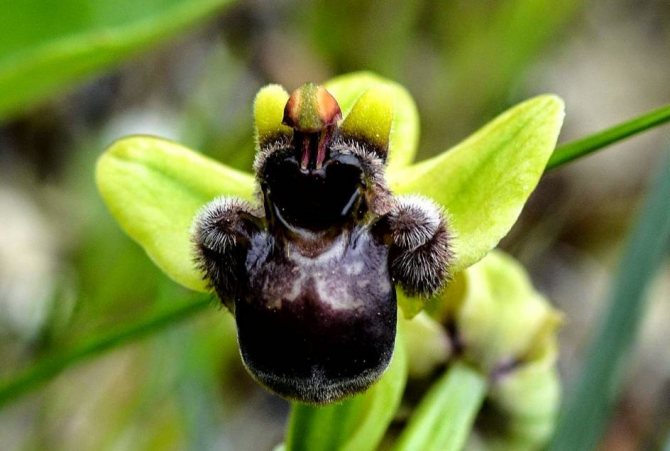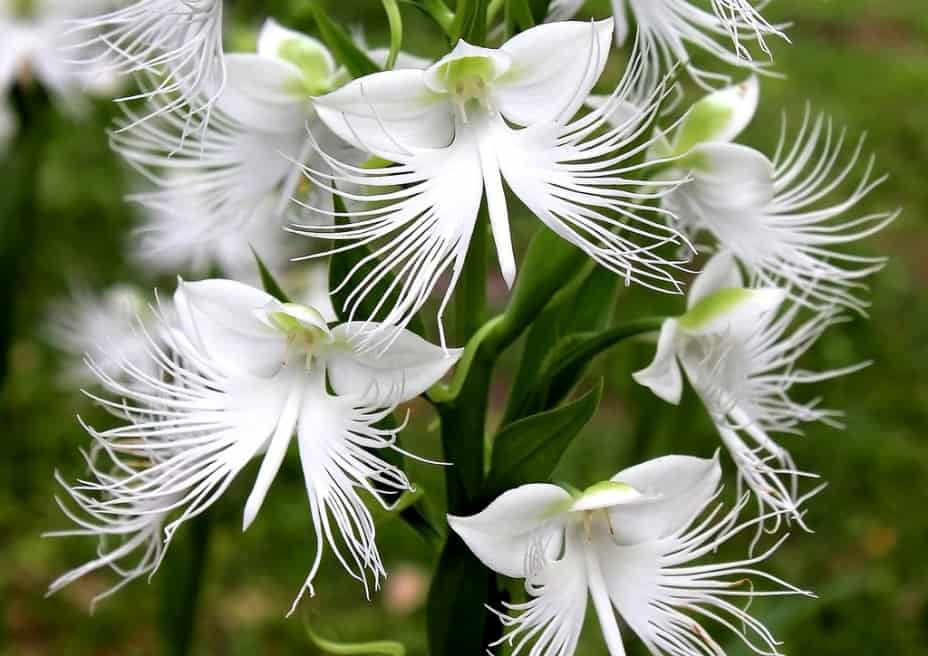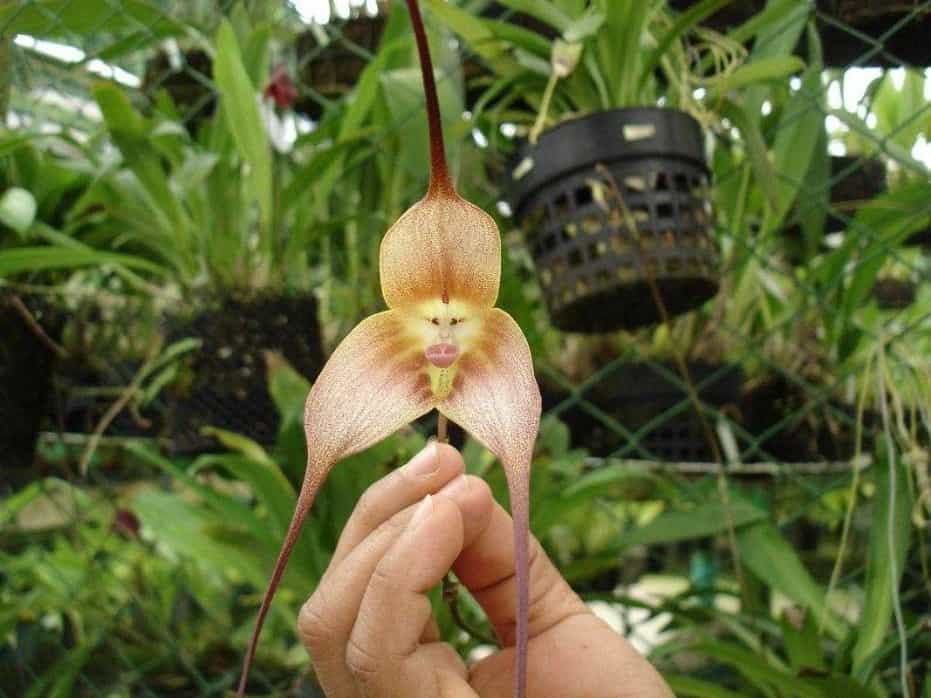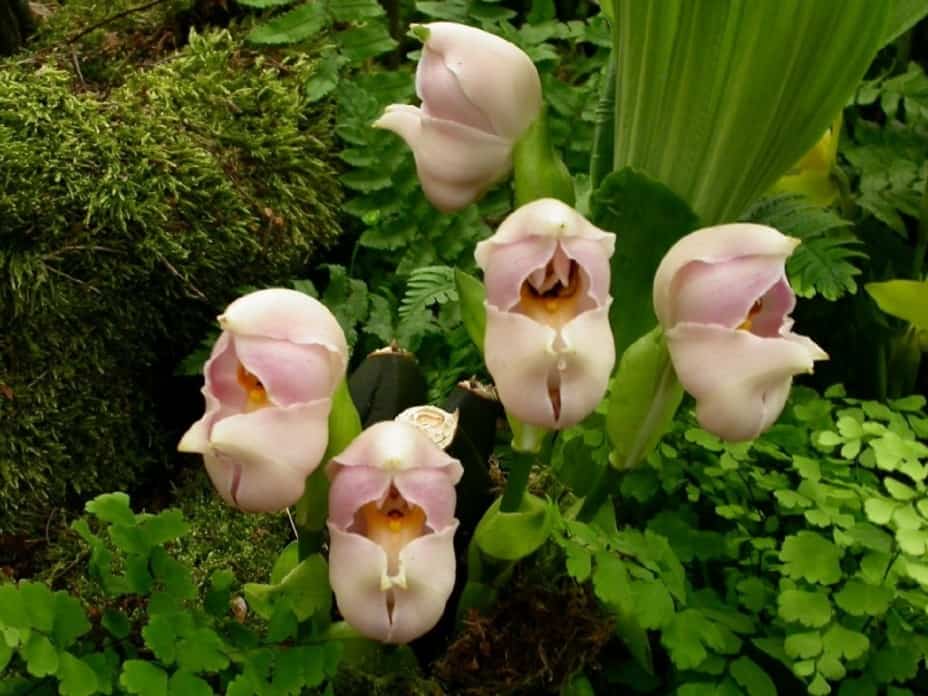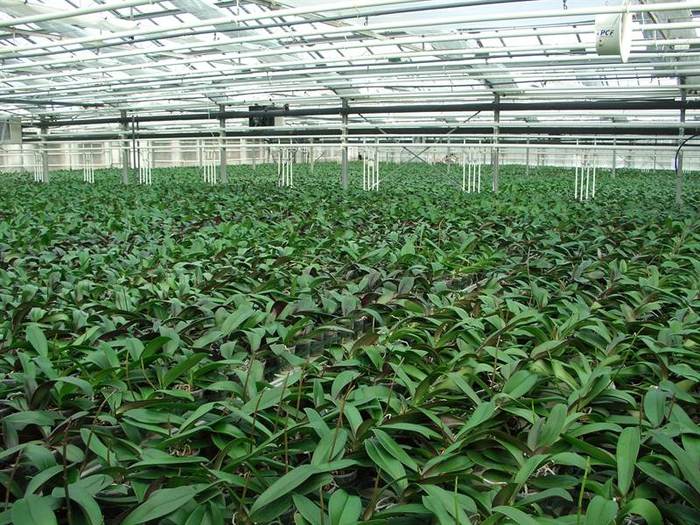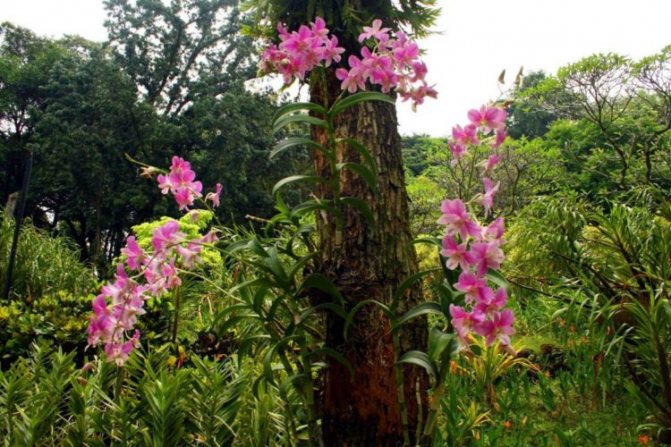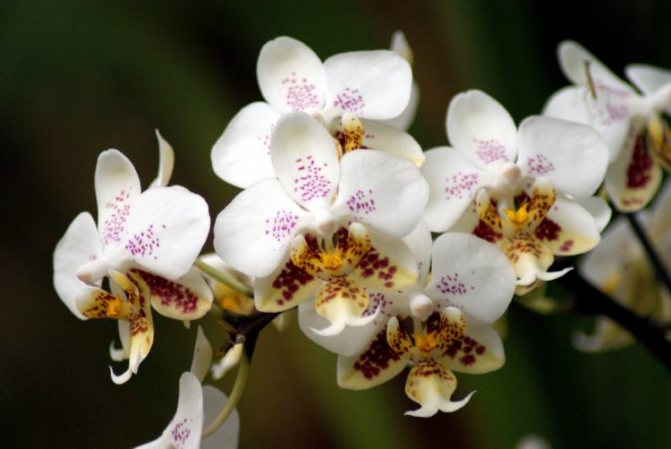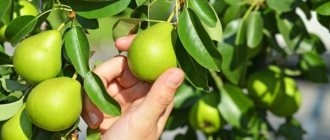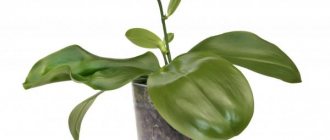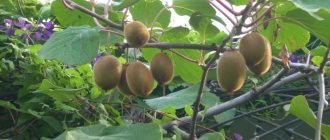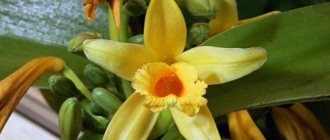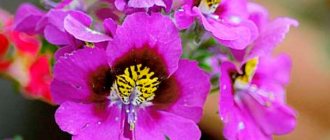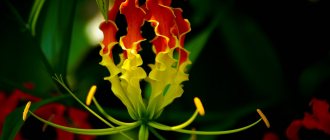The orchid has long become a habitual inhabitant of our apartments and houses. It is given for the holidays, collected and do not think about how it looks in the wild.
It is important for the owners of each domesticated orchid species to know what the conditions for their natural growth are.
Knowing in which country representatives of a particular species grow, the florist will better understand what an exotic beauty needs.
Planting an orchid at home

An orchid bought in a store does not always need to be transplanted, but only in a few cases:
- the flower does not keep in the pot, reasons: the leaves have grown on one side - you need not just transplant the orchid, but make the pot heavier or choose a heavy glass pots;
- if there was sphagnum moss in the shipping pot;
- if another pot is prepared for the orchid.
- there is little soil in the container, and the flower sways - fill up the substrate or transplant the orchid;
- root problems are visible through the transparent walls - the orchid must be urgently removed, bad roots removed, the cuts should be sprinkled with charcoal and replanted; if there are few healthy roots left, then the peduncle will have to be cut off, otherwise the plant will die, the roots will not be able to fully provide it with nutrition;
Planting methods
The orchid is planted in a transparent pot, because its roots participate in photosynthesis on a par with leaves. There should be many holes at the bottom for water intake and excess drainage. The orchid pot can be plastic or glass. For step-by-step instructions on how to plant, see the Orchid Transplant section below.
Optimal planting time
The best time to plant is spring.
Soil for planting
Orchids are not suitable for ordinary soil: their roots are used to receiving a lot of air, at home most of them grow on trees. It is better to buy a ready-made orchid substrate. Then the plant is guaranteed normal air permeability. If this is not possible, you can mix pine bark chopped into small pieces (pieces about 1-2 cm in size) with garden soil.
The bark must be boiled within an hour. Crushed charcoal is added to the mixture.
The first confirmed mentions of orchids
Scientists considered the orchid family to be almost the youngest among flowering plants. For some time. There were many hypotheses. But a piece of amber about 15-20 million years old with a bee changed many ideas. On the chest of this bee there was a pollinarium as material evidence. It is in it that orchid pollen develops:
- Scientists now agree that orchids are about 130 million years old. And at 65 million years they were already divided into five lines. These lines correspond to the current subfamilies. These are the spreads. Plus or minus ten million years;
- But in fact about their existence for the first time were able to record in China. The drawings and hieroglyphs used were depicted somewhere around 500 BC:
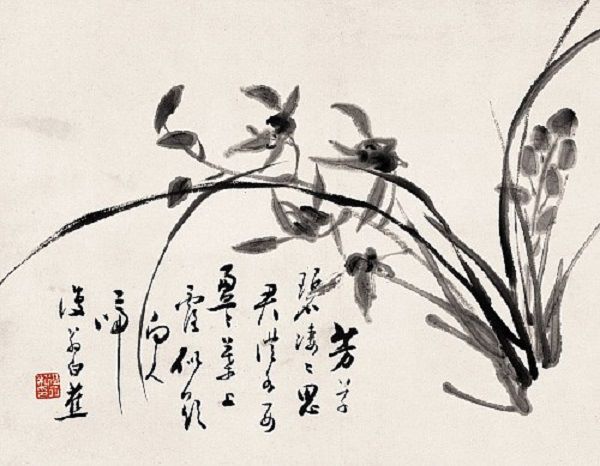

The artists painted the Tselogyns and Cymbidium; - AND in writing... Hieroglyphs have been used for over 2500 years: Lan - orchid;
- Tin Lan - heavenly orchid
- Lan Fong - orchid scent;
- Yeuk Lan - looks like an orchid.
- His works on botany "History of plants" (Historia plantarum), "Causes of plants" (De causis plantarum) and are now known. They mention the word orchis. And in ancient Greek it means Orchis (testicle);
- Another Greek scholar Dioscridus also could not ignore orchids in his works;
- Orchids were taken seriously in China... From the 10th to the 17th centuries, several treatises on these plants appeared. One of the first did not talk about their cultivation. Attention has been paid to how to use them. To decorate the house and ensure its safety (protection from evil spirits);
- In Japan - only 1728... Compared to Europe, this is not only, but already.
Features of orchid care
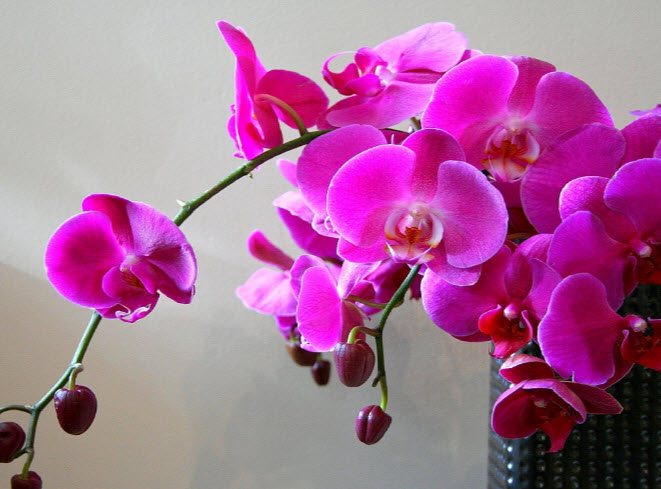

In the process of caring for a plant, there are three main components: light, watering, temperature.
Location and lighting for the plant
Properly organized lighting is the key to successful orchid breeding. They need a lot of light, but it should be diffused, soft. In summer, sunlight is filtered using curtains or special filters that are glued to the window.
In the fall, you can let the sun's rays into the room: they will no longer be able to burn the delicate leaves of the flower. In winter, it is not only necessary to remove everything that hinders natural light, but also to supplement it with artificial light. Daylight hours for orchids lasts up to 12 hours.
It is desirable that orchids stand on the southern windowsill, especially from autumn to spring, but they do well in the southeast and southwest, although there will be a problem of additional lighting. With good artificial light, some types of orchids feel comfortable on northern windowsills. Orchids can be taken outside, but do not forget to shade in time and do not expose to a draft.
Air humidity
Plants need high humidity. It is useful to spray regularly, increase the humidity in different ways, but only in a warm room. With cold content and high humidity, the orchid can rot the roots. Under all conditions, care for orchid leaves must be ensured by carefully wiping them with a damp cloth and sprinkling them.
When growing miniature orchids, the problem with moisture is solved simply. It is convenient to grow them in an aquarium. At the same time, watering is minimized: they have enough moisture in the environment for a long time and its supply in pseudobulbs.
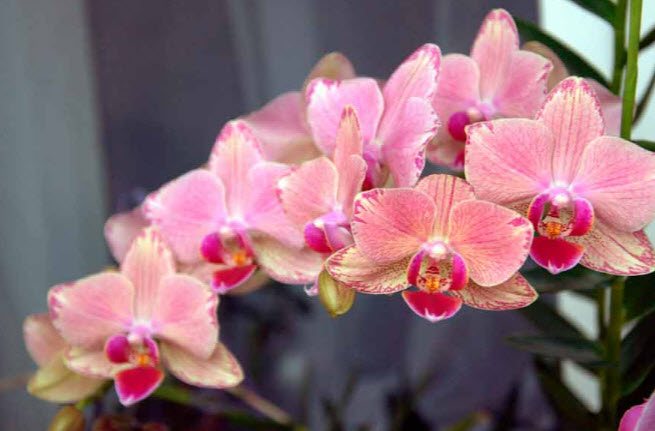

Temperature regime for orchids
To choose a temperature for orchids, you need to know that different types of plants prefer different temperatures. You can distinguish:
Heat-loving
They need high temperatures, reaching 30-32 degrees in summer and not falling below 20. In winter, they grow at 15-18 degrees, but the difference between day and night temperatures should not be more than 3-4 degrees. These orchids are native to tropical forests: they are mainly phalaenopsis, dendrobiums, and some varieties of Cattleya.
Growing at medium temperature
In summer they will be satisfied with a temperature of 18-25 degrees, in winter 12-15. These orchids were once brought to Europe from the tropics, but from the mountains and foothills, hence the low growth temperatures. These are miltonia and odontoglossums.
Cool temperature lovers
In summer, such orchids will grow successfully at a temperature of 18-22 degrees, and in winter, 10-13 is enough. They are from highlands and subtropical regions. Australian dendrobiums, almost all papiopedilums.
But most orchid owners bought them in a store or received them as a gift, again the donor bought them, as a rule, at the nearest flower kiosk. They themselves and their ancestors were raised in Europe, most likely in Holland, and will feel great at temperatures of 20-27 degrees in summer and 15-18 in winter.
Orchids get sick stuffy in rooms: the room should be regularly ventilated. But you can't make drafts.
How to water properly
To organize the correct watering, one must have a good idea of the conditions under which the orchids grew in nature. And bring watering as close to natural as possible:
- all orchid plants are epiphytes, therefore, they can easily endure a short break in watering, but this should not be allowed often: the leaves of the orchid will begin to wrinkle;
- some orchids (phalaenopsis, cymbidium, pafiopedilum) like the substrate to be constantly slightly moist; others (oncidium, dendrobium, cattleya) require the soil to dry out first;
- the water should be soft and warm; ideal rain or thawed warmed up; tap can be boiled;
- it is better not to water the plant from above, but put it directly in a pot in a bowl of water and leave for a few minutes, then take it out, let the water drain.
Orchids in nature: how and where do they grow?
The orchid is a very common plant and it can be found all over the world in the amount of 35,000 items. They can be found on all continents in tropical and temperate latitudes.
The largest number of species of these beautiful plants grows in the tropics. These conditions are most suitable for orchids.
Orchids need warmth and moisture. With their special root system, wintering in cold regions is impossible, therefore, in an apartment, it is important not to allow a frosty air stream to enter.
Saprophytes
This kind unusual in appearance. Saprophytes are not like the phalaenopsis we are used to. These orchids have no leaves, grow on the ground and have deep, thick roots. Outwardly, they look like corals and do not create thin scions.
Form a symbiosis with myceliumfeeding on substances and water from humus and peat. The orchid has a thin stem covered with scales. Flowers are small and inconspicuous.
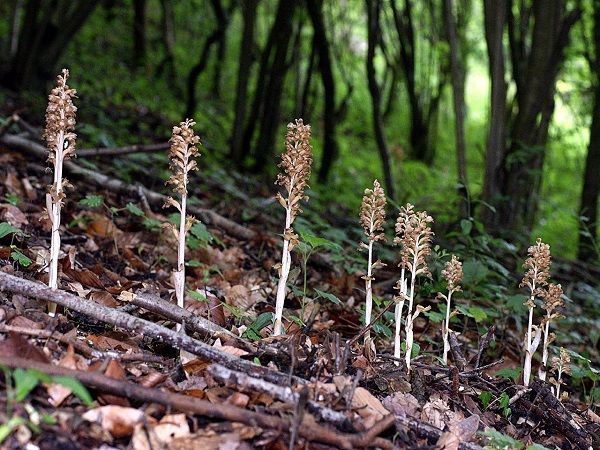

Saprophyte Common nest.
The absence of leaves and chlorophyll allows the plant to live in shady places under the crowns of trees.
Epiphytes
Orchids of this group are the most familiar and familiar to all flower growers. It is epiphytes that are common species such as phalaenopsis and wanda.
Epiphytes do not grow on the ground. Their roots contain velamen, which, like a sponge, absorbs water. In an effort to hide from herbivores and excess water, the orchid climbs on vertical supports. It can grow on wood or stone.
Many people incorrectly believe that epiphytes are parasites. Being on a tree, the orchid does not harm it, does not damage the bark. It receives water from the environment. Warm tropical rain, morning dew and fog satisfy the plant's fluid needs. Thick leaves and roots are capable of retaining moisture for a long time, so unexpected drought is not terrible for epiphytes.
The abundance of colors and shapes makes the flowers of these orchids attractive to insects, and the climate conditions are ideal for seed propagation. Under natural conditions, orchids easily form seed pods., their flowers are large, and the leaves reach a length of thirty centimeters.
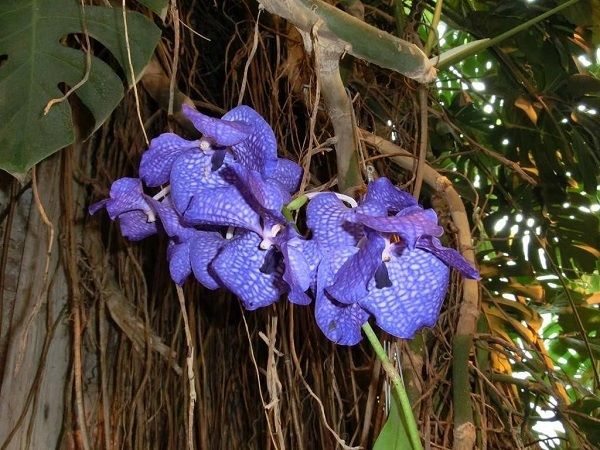

Epiphyte Wanda.
Epiphytes bloom all year roundforming long inflorescences. Seeds remain viable for up to 2 years, because even under ideal conditions it is difficult to find a suitable place for a sprout.
Interesting! Epiphytes do not need soil or peat. They have adapted to live in trees, using them as a support.
Terrestrial
Such plants have green shoots and roots buried in the ground. Just like in epiphytes, velamen is present on their roots and there are no small processes. Such a root system needs a light soil with a high air content.
Land orchids prefer the upper layer of light forest land. It consists of moss, bark and peat. The water does not stay here for long, so this composition is ideal for terrestrial species.
The height of these plants in natural conditions can be higher than 60 cm. Growing, the root system gives new shoots, therefore the orchid it looks like a huge bush with many flowers. Each trunk blooms only once in a lifetime and gives all its strength to the formation of seeds and the growth of new shoots.


Terrestrial Cymbidium Orchid.
Orchids of this species are able to accumulate water in thickened shoots or in pseudobulbs. In an unfavorable period, some of them shed their foliage and lose part of the root system.
The brightest representatives of terrestrial orchids include:
- Cymbidium;
- Miltonia.
Fertilizing and fertilizing a flower
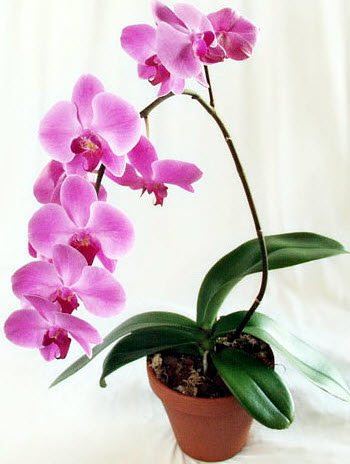

Ideally, you don't need to fertilize your orchid. She has enough supply of nutrients available in the substrate. But then the flower should be transplanted regularly every two years.
If there was no transplant, then it is better to add top dressing. You cannot take any fertilizer for flowers. They only need special ones for orchids. It is necessary to strictly observe the proportions named in the instructions. Fertilizers are applied during the flowering period once a week.
Pruning
Features of the process are to trim the arrow with a garden pruner. It is not produced immediately after the end of the flowering period. It is worth waiting until the peduncle dries up. If it is still green, the culture can please again with flowers. All actions are performed with extreme care so as not to damage the leaves and shoots. After removal, the shoots should be 2.5-3 cm long. The wounds must be treated. The inventory is also disinfected.
If you need to rejuvenate the orchid, then you should perform the following manipulations:
- remove excess leaves;
- clear the root system;
- update the substrate.
Orchid transplant
The flower is transplanted every two years to replenish the nutrients in the substrate. If the pot has become small, then it is transplanted more often. The plant is transplanted in the spring, but this cannot be done if the orchid has released a peduncle. It may not bloom.
Transplant methods
Transplantation raises many questions for novice florists. Here you need to follow a certain algorithm:
- carefully separate the walls of the pot and the root ball with a sharp narrow knife (the roots can grow into the pot);
- clean up old soil and cut off dead and rotten roots;
- pour a little soil into a new planter;
- install the plant in a pots, trying to keep it in the middle;
- gently spread the roots, they are brittle;
- first, little by little fill the voids between the roots, then the entire pot to the very edge, shaking it from time to time so that the substrate fills everything evenly;
- lightly crush the soil from above with something flat, for example, a spoon;
- After transplanting, the orchid is placed in a warm place and watered little by little.
Coating and watering
Cover the surface of the substrate with a layer of moss and do not water for 2 weeks after planting, but only spray the lower surface of the leaves.
In general, I usually only spray moss. For 2 weeks after transplanting, the plant has time to recover and heal broken roots. If there was rot somewhere, it dries up. In general, plants need these two weeks.
Unfortunately, it also happens that you dried the phalaenopsis, danced around him with a tambourine, but he died anyway.
Orchid propagation
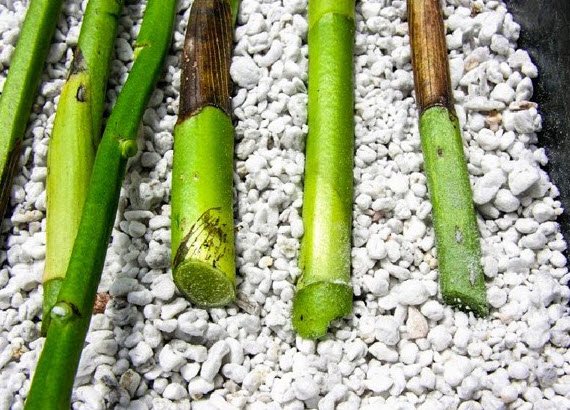

It is not difficult to reproduce it at home if you have certain knowledge.
Reproduction methods
There are two main ways: by seed and vegetative propagation. When propagating by seeds, you may not get a plant that is the same as the parent.
Division
This method works if the plant is large. Then the rhizome itself disintegrates during transplantation.It can also be divided:
- the orchid is taken out of the container and the roots are thoroughly cleaned from the soil;
- with a knife, which has been previously disinfected over an open fire, divide the rhizome between pseudobulbs;
- the sections are powdered with charcoal;
- flowers are planted in pots according to the method already described.
It is better to do this in the spring.
Propagation by cuttings
Not all species can be divided this way, but some, for example, Vanda, succeed.
The apical shoot is separated with a sterile knife, the cut point is dipped in crushed coal and planted in a pot.
Reproduction by children (stem offspring)
Many flowers, for example, phalaenopsis and dendrobium, give side shoots, babies. If such a baby has formed, then it should be protected, sprayed often and patiently wait for it to give roots. Then it is separated and planted in a container, sprinkling the cut with coal.
The appearance of such a baby can be provoked. This requires: high room temperature and nitrogen fertilization.
Reproduction by layering (pseudobulbs)
The pseudobulb is carefully separated and, after coal treatment, is planted in the ground. Further care is watering.
Seed propagation
Orchid seeds are very small, this is the main difficulty of such reproduction. It is used only by those who are engaged in selection. The seeds are placed in an artificial nutrient medium under sterile conditions so that molds do not develop, and germinate within 3-9 months. Then they are planted in a substrate and wait another 2-3 years until the plant can be transplanted. Orchids grown from seeds bloom only after 3-4 years.
Interesting Facts
The origin of the name for orchids is associated with the philosopher Theophrastus. As a result of scientific research, he came across an unfamiliar flower with roots in the form of a paired bulb and named it "orchis", which means "egg" in Greek.
In Europe, culture appeared thanks to an English botanist, who in 1731 was sent a dried flower from the Bahamas. He planted it, assuming that life was still preserved in the tubers. After some time, the culture came to life and blossomed.
When blooming, the smell of an orchid is not always felt. Only some of its species emit a pleasant, rich aroma. But there are also varieties whose flowers smell like mold, rotten meat. They are not suitable for home conditions.
There are species that are valued not for the beauty of flowers, but for the decorativeness of the leaves. Botanists do not distinguish them into a separate group. Orchidists do it. The leaf plates of such plants are distinguished by brightly colored veins, which look spectacular under the light of the lamp.
Interesting Facts:
- The flowers of the culture do not cause allergic reactions.
- Cut arrows last longer in water than other colors.
- The world's largest collection of the orchid family is collected in the Singapore Orchid National Park - 60 thousand species and 400 varieties.
- Vanilla is the thin, long fruit of the Vanilla Planiflora orchid that looks like a vine.
- The most expensive flower in the world is the Gold Kinabalu orchid, which blooms only after reaching the age of 15. The cost of one escape is about $ 5,000.
- In China, the culture is used to drive out evil spirits, in India - as protection from the bites of poisonous snakes.
- There is a predatory representative of this family. She only eats insects.
Orchid bloom
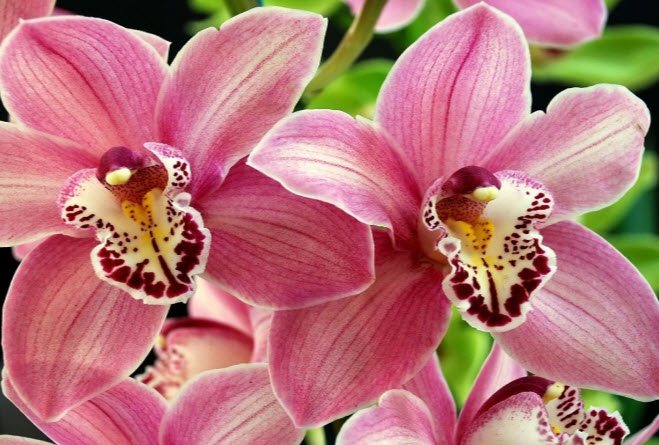

The store is buying a blooming orchid. Therefore, each owner faces two acute questions: is it possible to make it bloom for a long time and how to force it to bloom again if it faded quickly.
When the orchid blooms
They bloom when they reach the age of 1.5-2.5 years.
In order for the orchid to please with flowering, it is necessary to create certain conditions for it:
- provide a long daylight hours, the orchid must lay the required number of buds and form peduncles, this is a long process;
- be sure to need drops in day and night temperatures, during this period they can reach 5-7 degrees.
But if the orchid does not want to bloom, you can try to force it by arranging extreme conditions of detention:
- keep it for 15-20 days at a temperature of 15-17 degrees;
- significantly reduce watering during this period.
In different types of orchids, flowers differ markedly both in shape and in shades of color. But there is also something in common: the lower petal resembles a lip in shape, there are two sepals on its sides, two side petals rise above them, and the upper sepal completes all this.
Orchid care during flowering
An orchid, depending on the species and how many buds were laid in preparation for flowering, can bloom from 2 to 10 months. During this period, watering is doubled, the air temperature should be at least 20-25 degrees.
Orchid care after flowering
First of all, the peduncle is cut to give the opportunity to form a new one. The orchid can be fed, followed by the usual care.
Common species
Royal
The royal orchid is called large-flowered variety of phalaenopsis... It is distinguished by the large size of flowers (from 10 cm), long peduncles and wide leaves.
In the natural environment, phalaenopsis of this size is difficult to meet, since this is the result of selection. However, it can be found in the rainforests of India, Indonesia and China, provided many factors coincide.
Epiphyte picky about bright light and nutrients. If one of the conditions is lacking, the plant produces smaller flowers.
The flower stalk of the royal orchid reaches a height of 1.5 m, it can branch. Smelling representatives are common.
Flowering continues up to 7-8 months. The plant takes a lot of energy to maintain large flowers, therefore the second peduncle appears extremely rarely.
Lyubka is two-leaved
Plant often found in temperate forests and has a second name - night violet. It has an unsightly appearance, small white flowers and a delicate scent that attracts insects.
This is one of the wintering orchids. Survives frost due to the presence of a tuber, which is a thickening of the root for the accumulation of nutrients. Forms a symbiosis with mycelium, is renewed every year by dying off and growing a new one. Young tubers must be harvested for medicinal purposes.


Lyubka is two-leaved.
The flowering period is May, June. Forms seed pods in August, leaves and peduncles die off in autumn.
Reproduction takes place only with the help of seeds, therefore the collection of flowers of Lyubka two-leaved leads to the extinction of the species.
Attention! Lyubka two-leaved is an endangered species and is prohibited from harvesting in the forests of Russia.
Lady's slipper
The plant gets its name from its unusual petal shape. The lower part of the stigma was formed as a result of the accretion of two petals, which formed a "shoe". There is a legend about the goddess Venus, who lost her shoe while walking in the forest.
Natural habitat is temperate forests... The plant is capricious and is on the verge of extinction due to collection. Listed in the red book.
In its natural form, it is rarely possible to see a lady's slipper. It can be found in nature reserves, botanical gardens, and places where people rarely go.
The plant is shade-loving, demanding on moisture... Only grows in light soils with neutral pH and high lime content.
Vegetative and seed reproduction, making it easier for the species to spread
Interesting Facts:
- Long-liver. Lives up to 100 years and more;
- For seed germination, a mycelium is required;
- Prefers to coexist with pine and birch at the same time;
- Flowers form only in mature plants that are more than ten years old;
- Is on the verge of extinction;
- It has a second name - Russian orchid.


The lady's slipper is protected in all European countries.
Lady's slipper has a different color... Its flowers can be yellow-burgundy, pink, white and green with various spots and wavy petals, exudes a pleasant aroma.
Orchis spotted
Medicinal plant orchis spotted is familiar to many growers as "cuckoo's tears". Unlike most orchids, prefers clay, swampy soils... The plant is distributed throughout Russia, excluding the region of the Far North.
The root system forms a tuber that stores nutrients and easily survives cold weather. With the arrival of spring, the bulb gives all its strength to growing flowers, leaves and a new nodule.
Orchis tuber is harvested for medicinal purposes, since its pulp contains a large amount of nutrients. Bulba is edible and can last for a whole day.
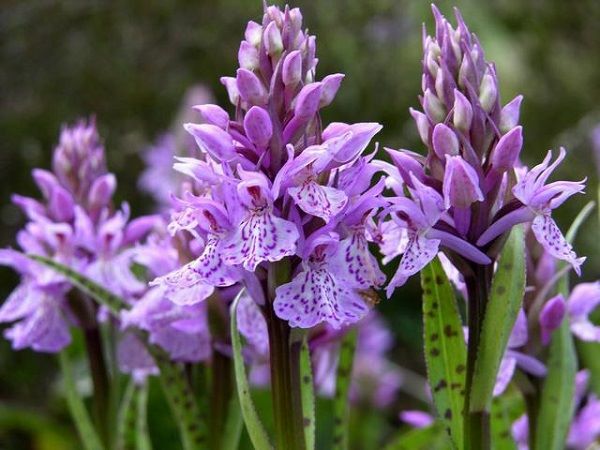

Good to know! Spotted orchis survives transplantation well and is easily "cultivated".
It blooms in early summer with small lilac flowers... By August, ripe seeds are formed, however, in order to germinate, they need a symbiosis with the mycelium. In addition to seeds, it reproduces vegetatively.
Goodayera creeping
Found in coniferous forests of the Moscow region... Its feature is a creeping rhizome, with which it reproduces.
A special feature of this orchid is its ability to go underground... When there is not enough light for the growth of green shoots, it transforms into a saprophyte form, forming a symbiosis with bacteria and fungi.
After improved lighting, it releases greenery and blooms. If the conditions have not changed, then he dies.
Nesting
Common nest is an unusual plant. His appearance does not remind of her beautiful relatives. The plant does not have green leaves and is a saprophyte... Its main color is brown.
The roots form a tight bunch, reminiscent of a bird's nest. Because of this feature, the nesting got its name. From the roots there are yellowish-brown shoots with a tassel of flowers exuding a sweet aroma.
Interesting! The common nest reproduces only with the help of seeds, of which more than 10,000 are formed in one flowering.
Pest disease problems
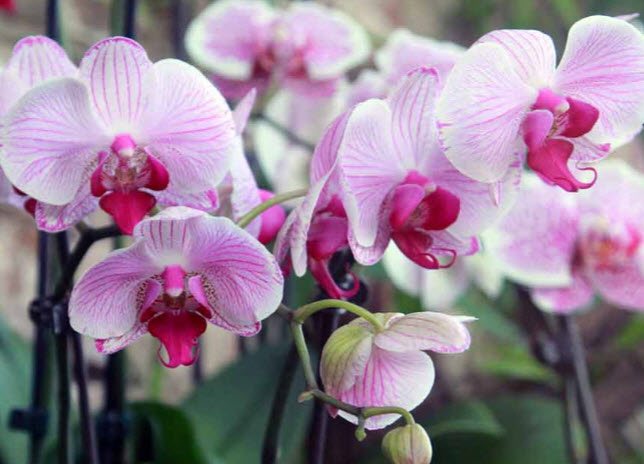

Diseases:
- anthracnose - manifests itself as brown spots with dots on the leaves; it is treated with preparations containing copper;
- fusarium - rotting spots appear on the leaves, this happens due to excess moisture — they are transferred to a dry room and watering is stopped;
- rust - rust spots on the bottom of the sheet — cannot be treated; the plant is destroyed so that others do not get infected;
- black rot - sprouts and leaves die off, the reason is in a too cold room - it is better to destroy the plant so as not to infect the rest.
Pests:
- aphid - destroyed by a mixture of milk and water in equal proportions;
- soft mite - the affected areas in the form of rosettes are cut out and sprinkled along the edge with ash;
- spider mite - the whole plant, window and windowsill are thoroughly washed with soap;
- scabbards - live in growths and bumps, get rid of them with the help of soap suds;
- thrips - translucent bugs living at the bottom of the leaf, the affected areas are cut out.
If such methods do not help, then they turn to chemicals and process the plant according to the instructions.
Distribution in the world
When purchasing a beautiful flower in a store, we can not always even imagine the habitat of orchids. Where they just do not grow.
There are many types of orchids - about 35 thousand. They are so different. And their natural habitats are far from the same. Even very different. So what is the difference between them?
Representatives of orchids surprise not only with their beauty and originality. But also its ability to survive in different climates:
- Hot and harsh;
- Rainy and dry;
- Forests and steppes;
- Mountains and plains.
The continents are easier to list. And we can say that all continents. Except for one - Antarctica. But the countries will have to be named for a long time. Below we will name some.
Tropical epiphytes
The very word epiphyte means a plant growing on another plant. Or attached to another plant - forophyte. So they grow:
- On trees (branches and trunks);
- On stumps and snags;
- In the crevices of the stones;
- And even on sheer cliffs.
Such plants live off moisture, air and remnants of the bark. Their roots are also called airy:
- With their help, they are attached;
- These roots absorb moisture from the air and damp wood surfaces;
- And they also participate in the process of photosynthesis.
Herbaceous species of temperate latitudes
Can such an orchid grow in the ground? So to speak - they cannot do without soil... They have underground rhizomes or tubers. They find a kind of soil - breathable and moisture-permeable pieces of bark, stone chips, roots.


Some species - on the surface of the earth in layers of fallen leaves, branches and bark of trees, overgrown with moss and small stones. Such orchids have few leaves. Quite often, only one.
Conditional division by climatic latitude
The variety of orchids required some analysis and systematization. They were divided into five subfamilies:
- Herbaceous perennials. Each of them includes many tribes: Apostasy;
- Cypripedia.
- Vanilla.
- Epidendric.
- Orchids or Orchids.
There is also a division by climatic zones and territories. It is more conditional. And it includes four groups:
- Tropics. Bright and ventilated places near rivers. On the slopes of the mountains. Epiphytic species grow predominantly: the coast of Africa, South and Central America, eastern and northern Australia;
- Adjacent areas of the Amazon and Congo rivers.
- Foothills of the Himalayas;
- Highlands and arid zones. With their temperature fluctuations (hot days and cold nights), they are suitable for many types of terrestrial orchids. And some epiphytic ones. And they grow near rivers and reservoirs.
- North America;
Popular species (varieties)
- Phalaenopsis orchid—The most widespread species in indoor floriculture, there are many hybrids on sale that successfully grow in the house;
- Dendrobium nobile orchid - there are many varieties, they all bloom in spring, the most popular is white orchid, such plants, which have a pure white color, come from Thailand;
- Cambria orchid- an artificially bred plant, it blooms for a long time, grows well on the windowsill;
- Ludisia orchid—A plant with very beautiful leaves, grows indoors only with very high humidity;
- Miltonia orchid- Difficult cultivar to breed, but with very beautiful fragrant flowers, similar in shape to pansies;
- Cymbidium orchid—Very large plants, now miniature varieties have been developed that are so easy to care for that they are offered to novice growers;
- Cattleya Orchid- a species with spectacular waxy flowers, hybrids of which grow successfully in rooms;
- Orchid wanda - grows successfully indoors up to a meter;
- Oncidium - flowers resemble butterflies, grows in the house, but with strict adherence to the rules of care.
Growing at home
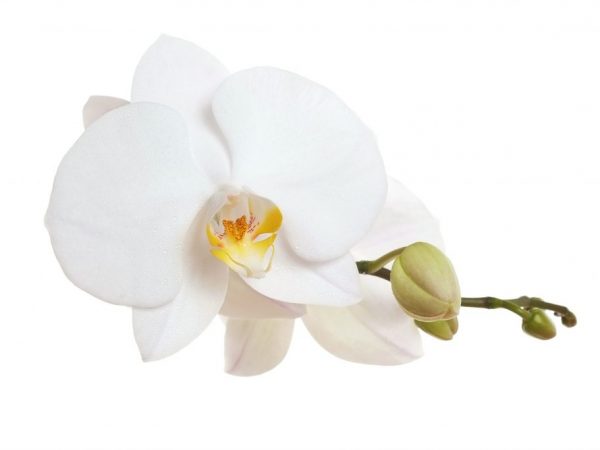

Features of the growth of orchids
Since the orchid is recognized as the queen of flowers, many want to have it in their collection. For beginner growers, the easy-to-care phalaenopsis ampelous orchid or bush dendrobium is most suitable for growing.
Choosing a flower
Before buying a plant, it must be examined. Signs of a healthy appearance:
- petals - bright and elastic;
- leaves - bright green, without spots, cobwebs, mold;
- roots - green or light, silvery (depending on soil moisture), fleshy and elastic.
If you are going to be transported home in the cold season, the plant is wrapped in several layers of paper, in frost it is additionally covered with a plastic bag.
Souvenirs from Thailand have become popular now - Thai orchid sprouts are placed in a glass bottle, as well as everything necessary for their life. When returning to their home country, tourists wait for the sprouts to occupy the entire volume of the vessel. Then they break it and plant the culture in a flower pot.
Quarantine
After purchase, the plant needs time to adapt. For the first two weeks, it should stand alone - separate from other indoor plants. At this time, watering is reduced, no fertilizing is performed, and direct sunlight is prevented. Then, little by little, the moistening of the substrate is renewed, the flower is accustomed to the sun.
Answers to readers' questions


What is the lifespan of a plant?
Each species has its own lifespan. At home, orchids live from 3 to 10 years.
Can this plant be kept at home?
This flower will be a decoration for any home.
Is this flower poisonous?
This houseplant is not poisonous.
Why isn't the orchid blooming?
No preparatory measures were taken.
Why do the leaves turn yellow (dry)?
The reason is most often in excess or lack of moisture.
Decorative color assignment
In addition to indoor varieties of culture, there are also street varieties. They are rarely planted. They are found even in Moscow parks, but these species look more modest than their tropical relatives. In most cases, these are orchids called "Slipper".
To preserve the vivid beauty of flowers, it is necessary to dry the fallen or slightly wilted inflorescences. Artificial plants of different colors are used in interior decor. The branches look especially beautiful in a floor vase. The beige color of flowers is perfect for complementing the interior of rehabilitation centers, holiday homes, as this shade personifies calmness and tranquility.
The flowers of the culture are so refined that even pastry chefs use their appearance to decorate cakes and cupcakes. For this, there are special silicone weiners, with the help of which artificial flower petals are created. A cosmetic fragrance is also made, which has an orchid aroma. The substance is used to make soap.
Where do our orchids come from?
For this delightful flower to be in our home, the whole industry has been working for several years. First, under laboratory conditions, microscopic orchid seeds or pieces of their tissues during mericlonal propagation are placed in sterile glass flasks with a nutrient medium. It is inside these containers that the miracle of the birth of tiny orchid seedlings takes place. Plants spend in flasks from several months to a year, after which they are transplanted onto a special substrate and grown in greenhouses. It takes years and several transplants to get a full blooming orchid from a tiny seedling.
The vast majority of phalaenopsis for the European market are grown in Holland - often from flasks imported from Southeast Asian countries (Taiwan and Thailand).


Origin
According to official docs, for the first time Phalaenopsis came to the European continent at the beginning of the 18th century.
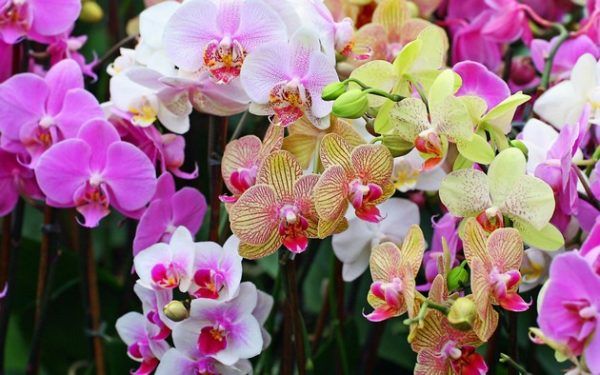

Thanks to the desire to "steal" the orchid from the wild, Phalaenopsis ended up in the homes of many flower growers.
Many people liked the beauty of a flowering plant, flower growers made a lot of effortto grow it in greenhouses, but all attempts failed.
Only almost 150 years later Phalaenopsis orchid appeared on the windowsills of many flower growers around the world.
Wandas with Ascocentrum


Flower care
Wanda looks original in transparent vases, without the addition of substrate and water.For watering and feeding, the orchid is removed from the vase, placed in water with dissolved minerals for several hours, then the roots are dried and returned to Wanda in a glass vessel. It lives in nature for as many years as its support will last. If the tree decays, Wanda may die too. Domestic orchids live as long as the owner will measure them with his care. They can delight him for one season, or for several years.
Species growing in the post-Soviet space
No one brought orchids from expeditions to the Soviet Union for planting and breeding. They have been growing on our territory for many centuries. The historical facts of their use by the Zaporozhye Cossacks are known. Both amulets and dried food.
The nature of the post-Soviet space is also rich in orchids. A total of 419 species from 49 genera. Only on the territory of Russia, Belarus and Ukraine there are about 130 species. And almost all of them are in the Red Book. These are not tropical beauties. They are terrestrial species... Take a look at the most famous ones.
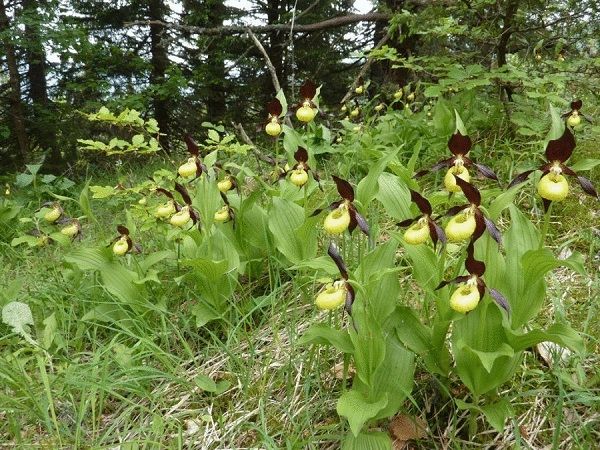

Lady's slipper.
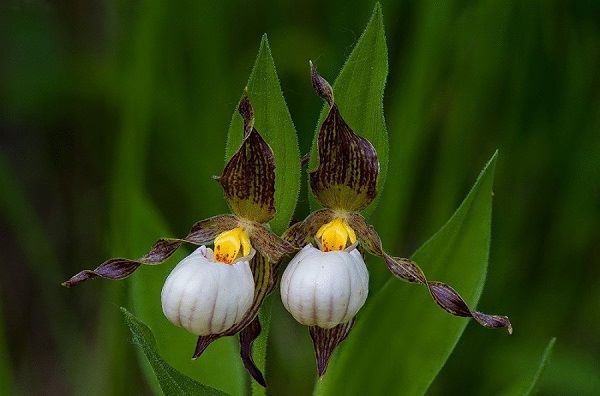

Small white shoe.
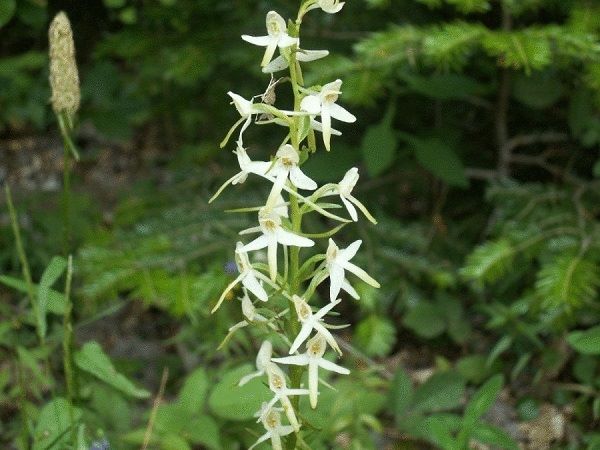

Lyubka is two-leaved.
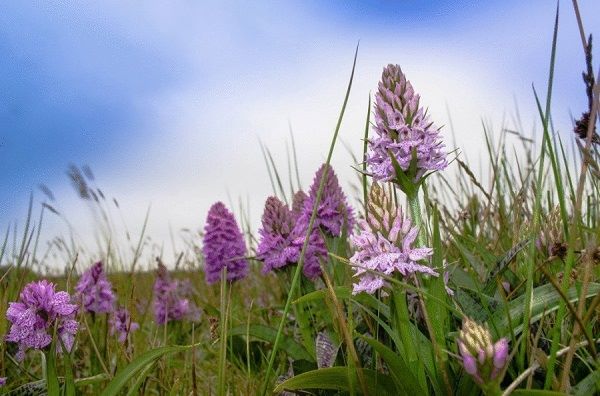

Orchis. Kukushka's tears.
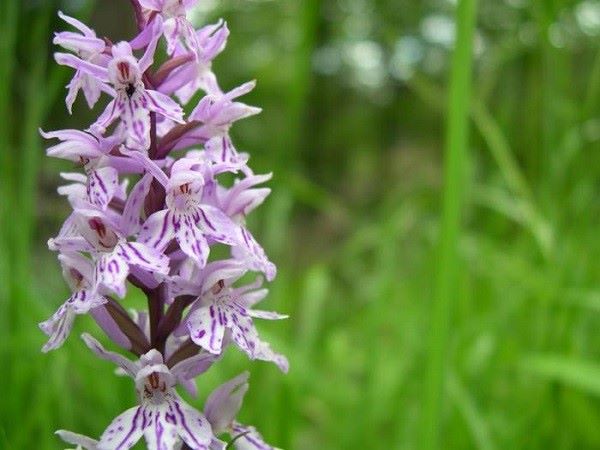

Finger-root.


Dremlik.


Comperia. It grows only in the Crimea. On the limestones of the southern coast.
Choosing a place for planting and preparing the soil
For growing an orchid plant, a usually tall and stable pot with a drilled or existing drainage hole is chosen. With an annual transplant, its size is slightly increased, but at the same time they try to choose such a container for planting so that it does not turn over under the weight of a growing tree and its abundant inflorescences.
A layer of drainage from expanded clay or small pebbles is laid on the bottom, and then specially prepared soil from 1 part of sod, the same amount of deciduous soil and half of sand. You can simply purchase a soil with a low acidity level at a flower shop.
Photo
Next, you can see the photo of the plant:
Myths and superstitions
Perhaps, they began with the fantastic story of HG Wells "Strange Orchid", in which the plant turned out to be a vampire and tried to kill its unlucky owner, a florist. Be that as it may, but in conversations and on the Internet there is often an opinion that orchids cannot be kept in the bedroom and in the house in general, because they are energy vampires, they release something harmful into the air, and in general it is not a matter of fen- I'm shoving. Believe me, all this is not true! Orchids are completely safe and even very useful plants: they improve the microclimate in the room and cheer up with their emerald greenery and wonderful flowers. Do not believe any nonsense and enjoy the beauty of this incredibly delicate, airy and very grateful flower!


Add to favorites4
- Tags:
- flowers
- houseplants
flowers, indoor plants
Where is it found?
Phalaenopsis is an extensive genus of orchids native to Southeast Asia. Many species of this genus grow in the Philippines and northeastern Australia. Presumably, the genus originated in the south of China, from where it spread throughout the rest of the present growing area.
For the first time a plant of this genus was found on the Ambon island in Indonesia by the German naturalist G. Rumph. However, the phalaenopsis became a real botanical sensation after one flower came to the famous scientist Karl Linnaeus. He described it in his work "Plant Species" under the name "adorable epidendrum."
On a note. The word "epidendrum" can be translated as "living on a tree."
Today botanists and experienced florists know that in nature, almost all orchids live on trees, however, at that time, scientists were almost unfamiliar with orchids. Subsequently, this species that fell to Linnaeus became a model for describing the entire genus of Phalaenopsis (the so-called name-bearing type). To this day, it is called Phalaenopsis amabilis - "lovely phalaenopsis."
The familiar name for these flowers appeared in 1825, when the director of the Leiden Botanical Garden, Karl Blume, traveling through the Malay Archipelago, found huge white flowers on tall stems in the thick of a tropical forest and mistook them for night moths. The error, of course, was quickly revealed, but Blume decided to call these flowers phalaenopsis - from the Greek words phalania - "moth" and opsis - "similarity."
Seasonal conditions (table)
| Season | Temperature | Lighting | Humidity |
| Spring | The orchid tree is a tropical plant. Summer prefers sunny and warm, with an average of about 25 ° C. Otherwise, a large number of empty, unopened buds are tied and the plant slows down in growth. It can withstand short-term temperature changes. | Can grow in partial shade. But still, bright light is preferable. It is good to keep the plant outdoors. But before being taken out into the street, the bauhinia should be gradually accustomed to sunlight. If the plant spends the summer on the south window, then it must be shaded. | Regards the natural humidity of the air calmly. There is almost no need for additional moistening and spraying, with the exception of the heating season. But you shouldn't get carried away. Never spray buds and flowers, they wilt quickly from this. |
| Summer | |||
| Fall | Winter maintenance involves a decrease in temperature to 12-15 ° C. When the bauhinia sheds its foliage, it will be able to withstand short-term frosts down to -5 ° C. | In winter, they are kept in a well-lit place. You can even put it on the sunniest window or turn on additional lighting. | |
| Winter |
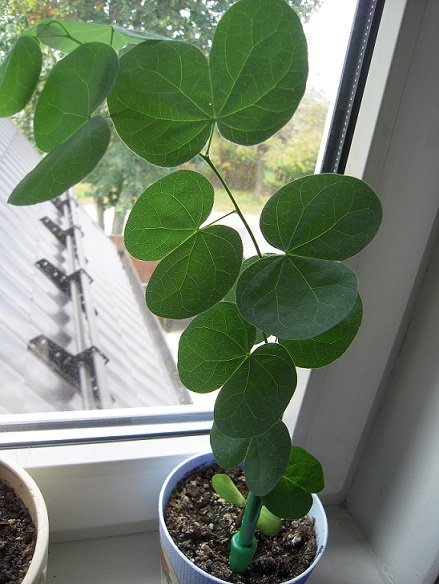

Bauhinia loves bright light
Wild orchids of temperate latitudes
The vegetation of the temperate latitudes also boasts extraordinary orchids, even if not as charming as American or Asian ones, but incredibly enchanting. They have their own special northern beauty, captivating with endurance, resistance to cold and amazing grace.
The brightest representatives of terrestrial orchids growing in the rather harsh climatic conditions of the temperate zone:
Large-flowered pollen head (Cephalanthera damasonium) and red (C. Rubra) are spectacular plants that disappear in nature due to the fact that they are massively collected for bouquets. The red pollen head has a much wider area of distribution, covering almost all of Europe and the temperate zone of North America.


The most fragrant kokushnik (Gymnadenia odoratissima) is an orchid with a very delicate pinkish inflorescence with a vanilla aroma, which appears no earlier than 5-7 years of age. A pronounced calcephile that grows in calcareous bogs throughout Western and Eastern Europe.
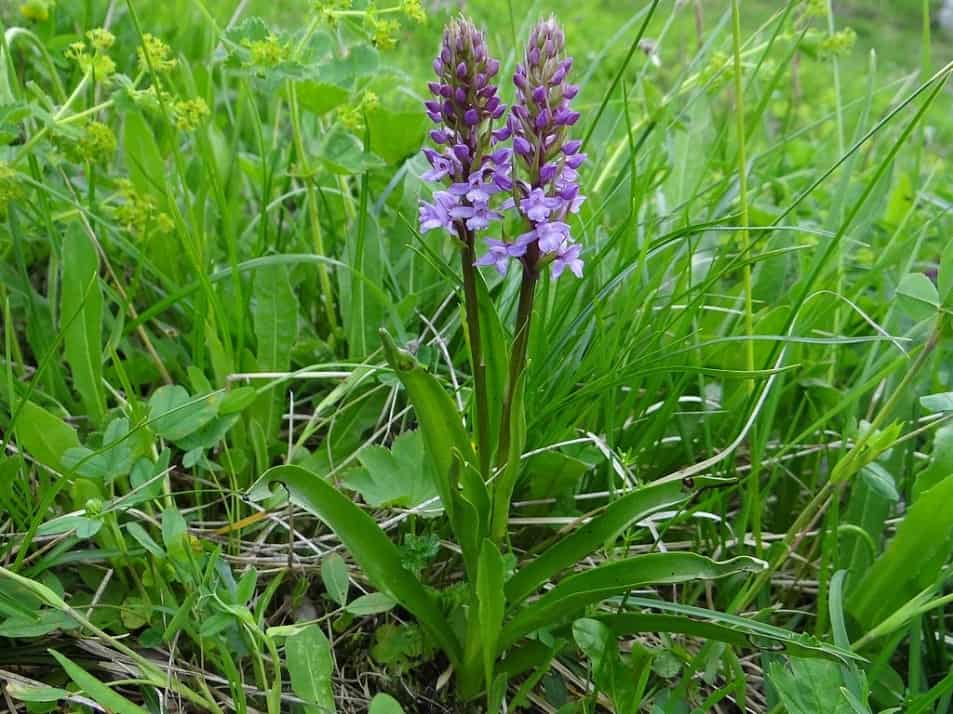

Dremlik dark red (Epipactis atrorubens) is a pubescent plant with foliage tinged with a lilac shade. The inflorescence with small dark cherry flowers, smelling of vanilla, rises almost 60 cm above the soil level. It grows in Iran, Western Siberia, Asia Minor, and Europe.


Bulbous Calypso (Calypso bulbosa) - lives in the cold regions of North America and Europe, reaches a height of 8–20 cm. The flowers are open, dark pinkish, with a light shoe-like lip with a speck or strip.


The real slipper (Cypripedium calceolus) is a universal favorite, common in Eurasia from the Pacific coast to the British Isles. Popular in garden floriculture.
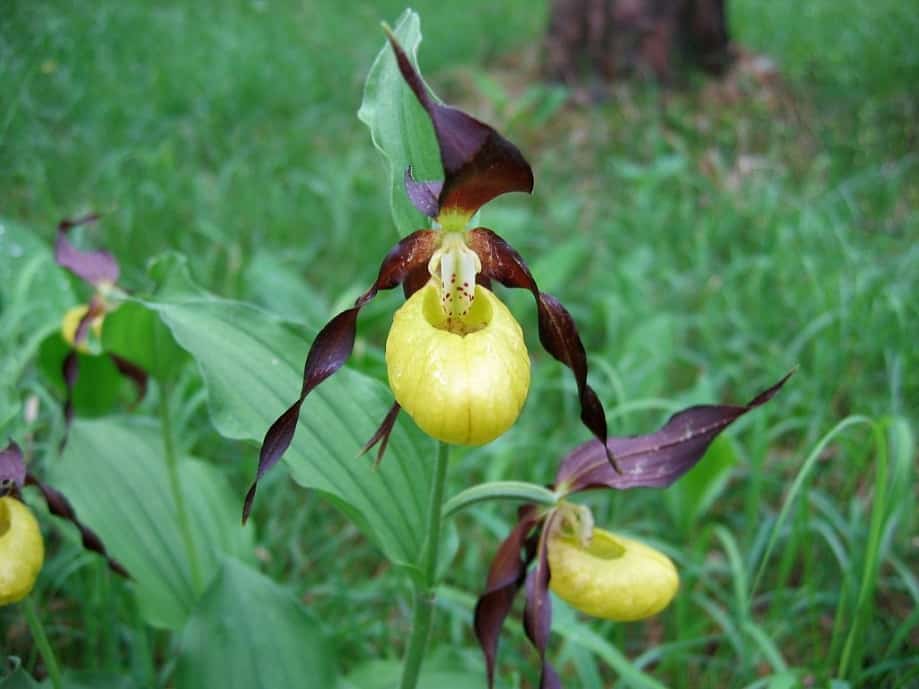

Lyubka bifolia (Platanthera bifolia) is a medicinal plant that has long been used in folk medicine. Due to its highly decorative qualities, it is used in the cultivation of temperate latitudes in Europe and in Asia Minor.
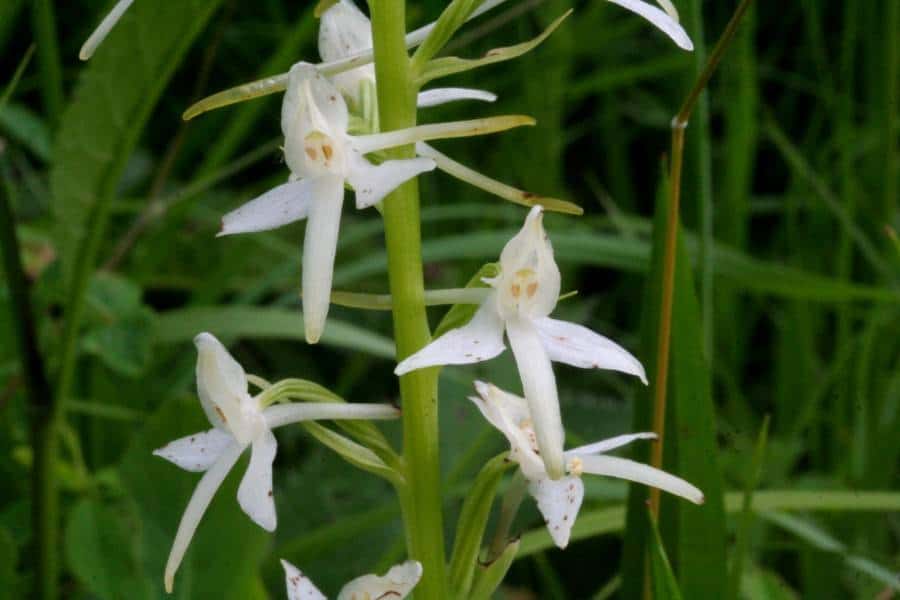

Anacamptis pyramidal (Anacamptis Pyram>
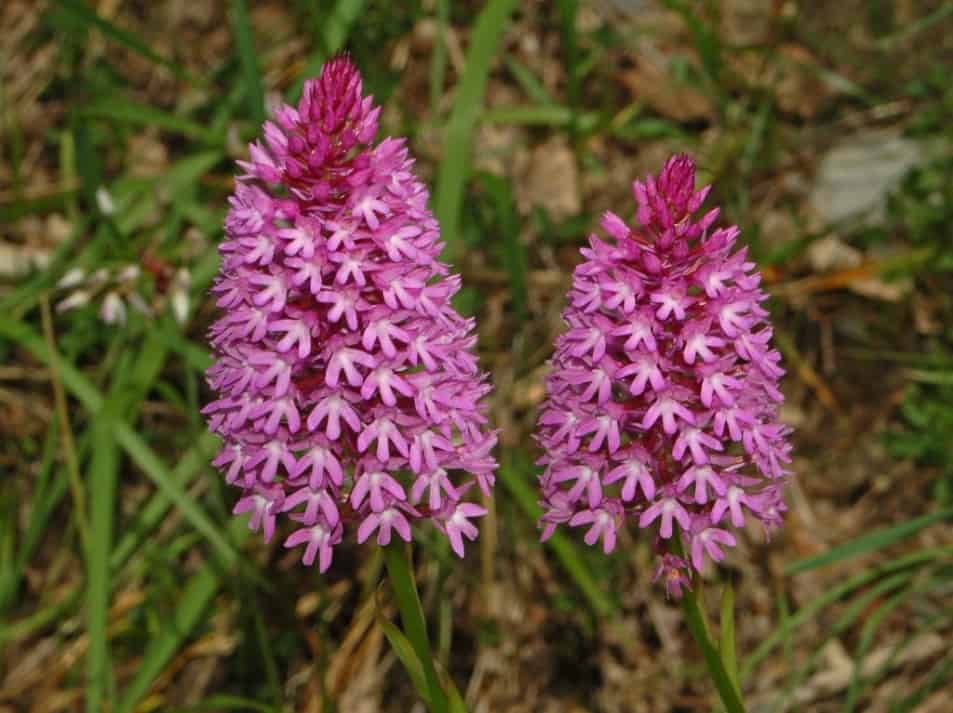

Comperia comperiana (Comperia comperiana) - naturally occurs off the southern coast of Crimea, in Turkey, Iraq and Western Iran. It has unusual delightful flowers with four filamentous appendages up to 8 cm long, flowing from the lobes of the lips.
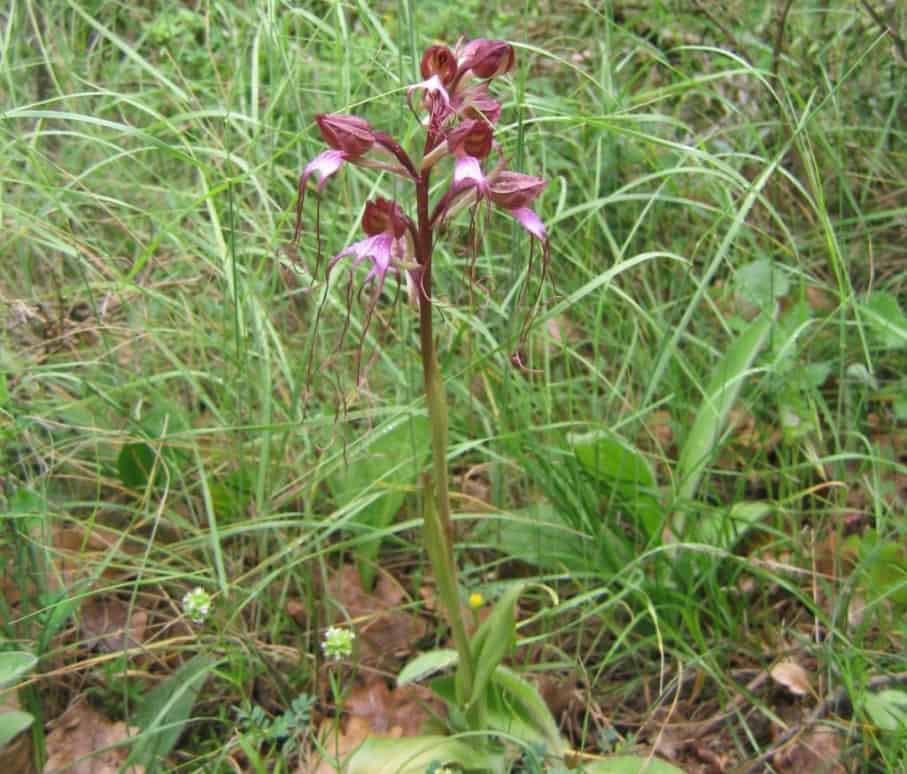

Traunsteinera globosa (Traunsteinera globosa) - lives on the alpine meadows of the mountain slopes of Europe and Asia Minor. Large globular lilac inflorescences rise on peduncles that grow up to 70 cm high and are visible from afar.
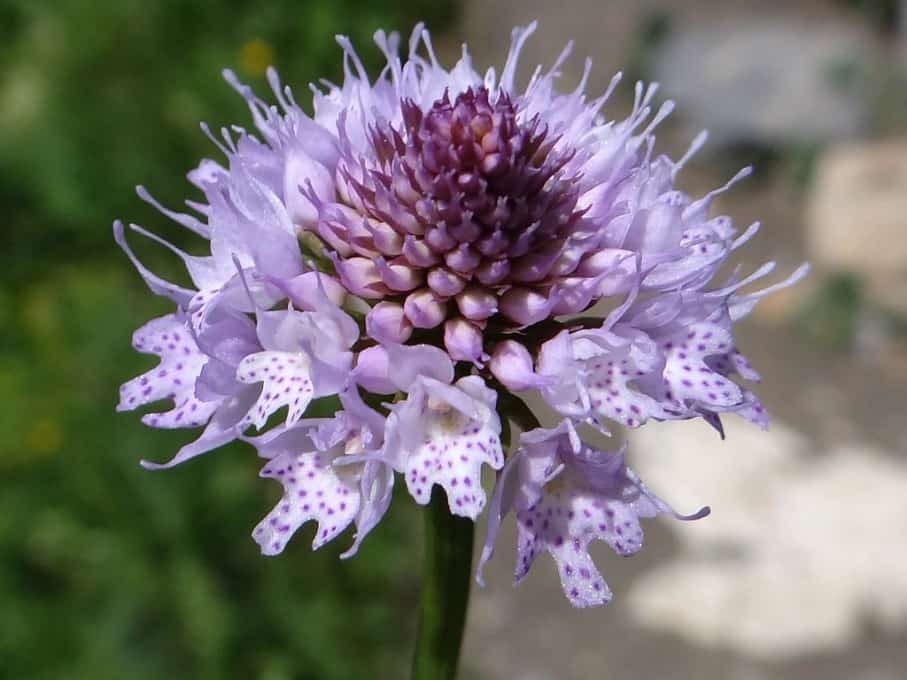

Fuchs' fingernail (Dactylorhiza fuchsii) is a Red Book species protected in many regions of the European part of Russia and Siberia; it grows in Ukraine and Northern Mongolia. A bright orchid with expressive purple-pink inflorescences 6–14 cm long. The lip is lighter with a sharply marked purple painting.
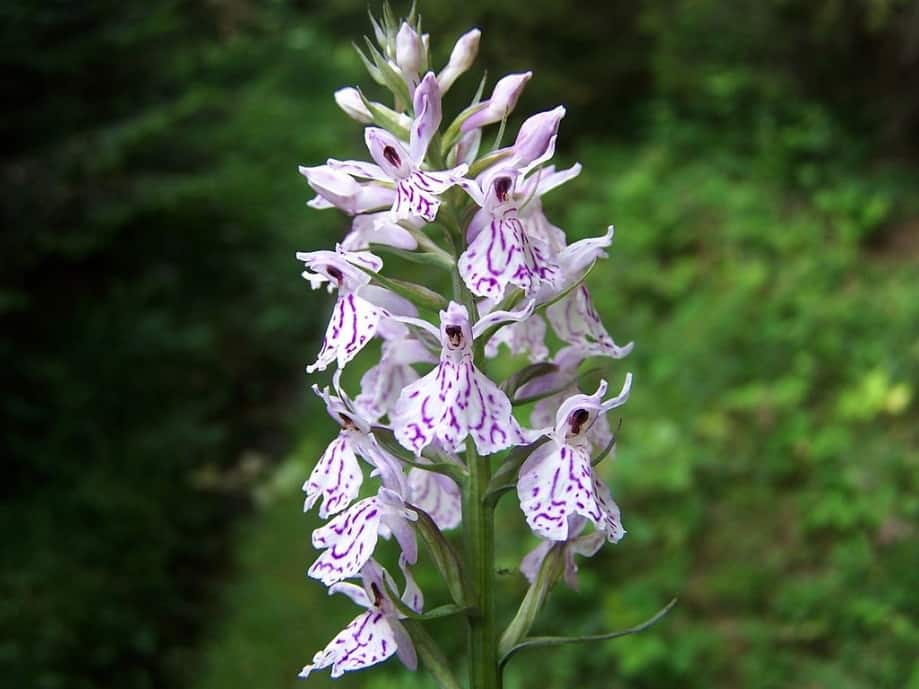

Life cycle
In natural conditions, the plant blooms several times a year.... Phalaenopsis practically does not have a rest period, although it is observed in other representatives of orchids. The climate in which the flower grows rarely changes. There are no sudden changes in temperature or cold snaps, and this contributes to constant growth.
There is a concept as biological and forced rest. After a new shoot grows, the flower retires. This happens under favorable climatic conditions.
On the ground
Such orchids are widespread in Europe. They put their roots deep underground, from where they get the necessary nutrients and water.
With the help of bulbs, also underground, it stores moisture in case of prolonged drought. They can grow up to half a meter above the ground and form flowering bushes.
Since the change of seasons is characteristic of the European area, it forms root cones in the ground before the coming winter, from which in the spring a new flower grows instead of the old one. And in tropical places, they can grow up to a meter in height and form a huge spreading bush.


Plant varieties: racemose, purple and others (table)
The genus Bauhinia has more than 340 species. This variety includes tree, shrub and lianas. In addition, they can be deciduous or semi-deciduous.
Despite the popular misconception, the Bauhinia blue variety does not exist.
It is also worth noting that not all species are flowering.
| Views | Description |
| Bauhinia purple | The plant growing in gardens and parks reaches 10 m in height. It has drooping shoots and lush foliage of a greenish-gray color. The shape of the leaf is double, the size is 12 cm. From September to November it blooms with purple flowers, collected to the brush. The most common type in home floriculture. |
| Bauhinia corymbose | The leaves have a heart-like shape, 4 - 5 cm long. They are attached to the stems with two-centimeter petioles. It blooms with small fragrant flowers, collected in racemose inflorescences. They are painted in a light lavender color, along the entire background of which purple-pink veins appear. It blooms from spring to autumn. |
| Bauhinia felt | A shrub with beautiful, forked, light green foliage and slender, flexible branches. The flowers are large, colored yellow. In the center of the flower there is a dark burgundy dot. Flowering begins in spring and ends in late summer. The fruit is a velvety pod to the touch. |
| Bauhinia racemose | Deciduous tree, 9 m high. It blooms in small clustered white flowers from April to September. The leaves are lobular, accrete to half, 12-15 cm long, pubescent. |
| Bauhinia monochromatic | A rare species, which is a tree with a rounded crown, growing up to 6 m in height. The branches are slightly drooping, the leaves are bilobate, 12 - 15 cm long. The blossoming flowers are white at first, then turning into pale pink. The upper petal has numerous strokes of bright crimson color. The rest of the petals are covered with small pink dots. |
Different types of orchid tree in the photo


Bauhinia purple


Bauhinia corymbose
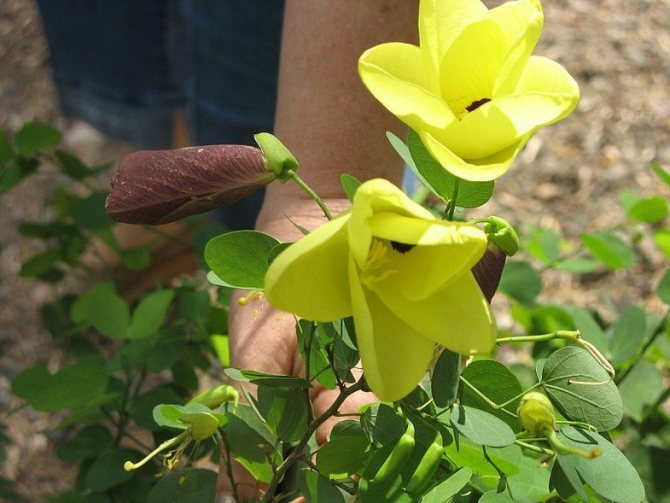

Bauhinia felt
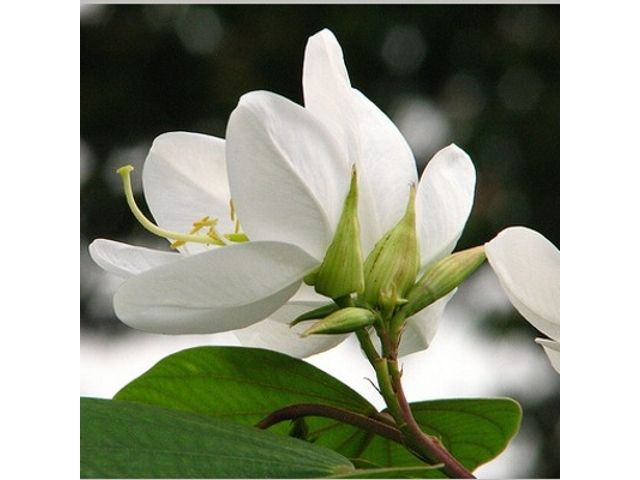

Bauhinia racemose
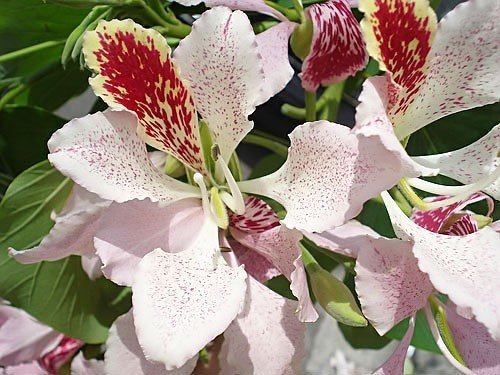

Bauhinia monochromatic
Favorable environment
Tropics, where phalaenopsis grows in nature, are the most favorable belt for her life.
Conditions created by nature, the important components of which will be the length of daylight hours, temperature, humidity, as well as possible contribute to its normal growth.
The trunk can be placed on a treebut it is not a parasite.
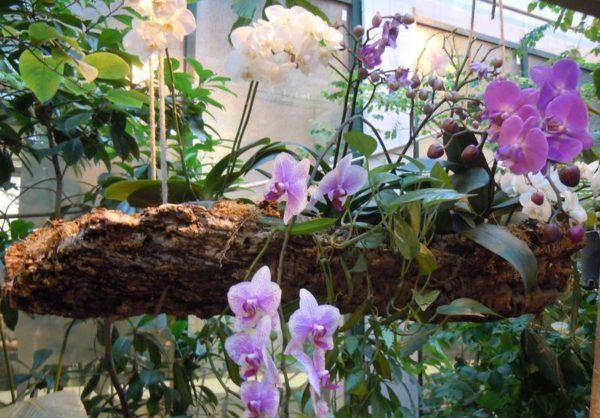

In natural conditions, the orchid is adapted to survive in the tropics without soil.
Phalaenopsis uses the trunk or branches of trees as support, this location helps the plant to absorb everything it needs by the roots as much as possible.
Orchids can also live on stones, placement on the rocks is also not excluded.
The main thing is that there is enough moisture.
Usually these types use multiple roots as fasteners, strongly braiding the stone. The rest of the rhizome feeds the stem.
In this article you will see a photo of the Phalaenopis orchid in nature in the most favorable conditions, blooming. You will read the history of origin, how the orchid grows and reproduces in natural conditions, its varieties.


In nature, all orchid roots are airy.


This is how orchids grow in the wild.


In natural conditions, the orchid consumes a sufficient amount of moisture.
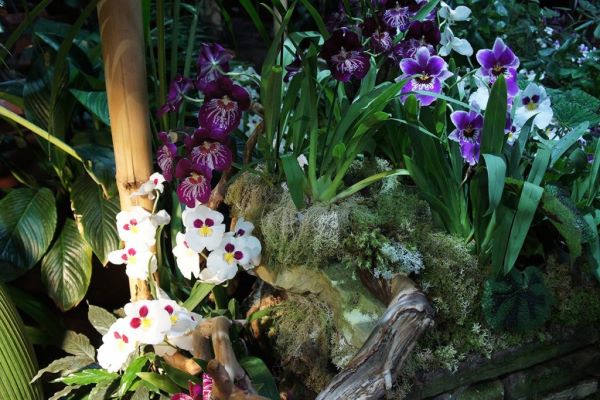

Orchids naturally grow on trees and on rocky slopes.
Differences from home
The main distinguishing feature of the indoor orchid from the wild one is the variety of varieties of domestic specimens. Natural exotics need certain conditions. It is very difficult to create them in a human dwelling. In the past, growers have tried to replicate these conditions indoors. But gradually modern breeders have created new varieties. Now exotic beauties have learned to exist in conditions of relative dryness.
Another basic difference between domestic and wild orchids is their lifespan. For example, in nature, phalaenopsis lives up to 70 years (according to some sources - even up to 200). In a human dwelling, the plant lives for 8-9 years.
A distinctive feature of indoor orchids is their lush bloom. Many domestic specimens are capable of blooming all year round, and in nature their counterparts often bloom only in summer.
Growing places
It is difficult to fit a description of orchids even on one page, let alone less text. Only on the territory of the former USSR (including Russia) there are 419 species of orchids, and all of them are quite different from each other. In total, the family includes more than 25 thousand species (several times more varieties) of orchids, plus more than 250 thousand hybrid varieties.
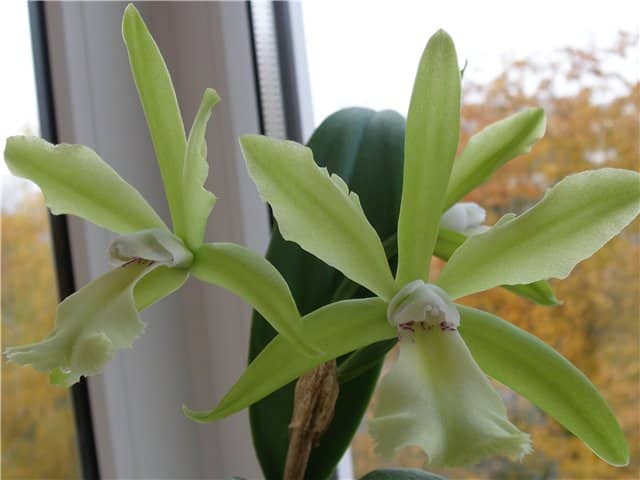

Growing a "home" favorite
In nature, this plant can be found all over the planet, from the forest-tundra to the tropics and deserts, from Alaska to the subantarctic islands. Any trees, rotting stumps, shrubs, rocks, tall anthills and just the ground can shelter these flowers. Perhaps the only place where this plant is not found is Antarctica.
The maximum number of species, varieties and specimens is concentrated in the tropics of Southeast Asia and America - frequent rains are most favorable for their growth and flowering. This family is quite common in Australia, Africa, Madagascar. Far fewer varieties are found in temperate latitudes.
Which material should you choose?
There are certain qualities that the material for the block must have.:
- durability and strength, since the orchid should not often be transplanted;
- at the same time, you need to choose a material that will not rot;
- it is very important that the material does not contain impurities harmful to the plant.
For planting, you can use a piece of bark:


Spruce and pine - can be used as a last resort. The material exfoliates very quickly, does not tolerate changes in moisture and does not last very long.- Cork bark - you can use either pressed or regular.
- Oak bark is an excellent, durable material.
- Elderberry and Amur Velvet.
There are a lot of poplars in cities, but this bark cannot be used, since it contains substances that are very harmful to the orchid.
You cannot use ordinary wood for the block, as it starts to rot very quickly, mold and mildew appear on it from moisture. You can use:
- mingling driftwood;
- wood of red, black and iron trees;
- grapevine;
- fern roots.
You can also use neutral synthetics - foam.
We recommend watching a video about the features of blocks for orchids:
Step-by-step planting instructions
There is nothing difficult, placing the plant on a piece of bark or on a snag... Let's consider step by step how to do it correctly:
- Prepare a suitable driftwood by shaping it to your liking.
- Make a hole for the hook at the top.
- The mount should be made of soft insulated wire or other durable material.
- Place the orchid on the driftwood. It should be noted right away that the leaves of the plant should look straight down, so moisture will not collect at the point of growth.
- The plant is attached with a soft cloth or synthetic mesh, you can use fishing line. If you plan to maintain high air humidity, then you do not need an orchid root support.
- But if this is not possible to achieve, then a layer of sphagnum is laid between the driftwood and the orchid, which will provide moisture to the roots and they will not dry out.
You can also transplant all epiphytes that currently grow in a pot onto the bark.... But you need to remember that the transplant should be done only during the period of active growth.
We recommend watching a video about the features of transplanting orchids into blocks:



